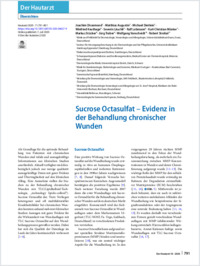[Sucrose octasulfate-evidence in the treatment of chronic wounds].
- Dissemond J Klinik und Poliklinik für Dermatologie, Venerologie und Allergologie, Universitätsklinikum Essen, Hufelandstr. 55, 45147, Essen, Deutschland. joachim.dissemond@uk-essen.de.
- Augustin M Institut für Versorgungsforschung in der Dermatologie und bei Pflegeberufen, Universitätsklinikum Hamburg-Eppendorf, Martinistr. 52, 20246, Hamburg, Deutschland.
- Dietlein M Diabetesschwerpunktpraxis Dietlein, Bauernstr. 50, 86391, Stadtbergen, Deutschland.
- Keuthage W Schwerpunktpraxis Diabetes und Ernährungsmedizin, MedicalCenter am Clemenshospital, Düesbergweg 128, 48153, Münster, Deutschland.
- Läuchli S Dermatologische Klinik, Universitätsspital Zürich, Gloriastr. 31, 8091, Zürich, Schweiz.
- Lobmann R Klinik für Endokrinologie, Diabetologie und Geriatrie, Klinikum Stuttgart - Krankenhaus Bad Cannstatt, Prießnitzweg 24, 70374, Stuttgart, Deutschland.
- Münter KC Gemeinschaftspraxis Bramfeld, Bramfelder Chaussee 200, 22177, Hamburg, Deutschland.
- Stücker M Abteilung für Dermatologie und Venerologie, LKH Feldkirch, Akademisches Lehrspital, Carinagasse 45-47, 6800, Feldkirch, Österreich.
- Traber J Abteilung für Dermatologie Venerologie und Allergologie am St. Josef-Hospital, Klinikum der Ruhr-Universität Bochum, Gudrunstr. 56, 44791, Bochum, Deutschland.
- Vanscheidt W Venenklinik Bellevue, Brückenstr. 9, 8280, Kreuzlingen, Schweiz.
- Strohal R Dermatologische Gemeinschaftspraxis, Paula-Modersohn-Platz 3, 79100, Freiburg, Deutschland.
- 2020-07-09
Published in:
- Der Hautarzt; Zeitschrift fur Dermatologie, Venerologie, und verwandte Gebiete. - 2020
Evidence-based wound care
Nano-oligosaccharide factor
TLC-sucrose octasulfate
Wound healing
Wound healing products
Anti-Ulcer Agents
Humans
Sucrose
Varicose Ulcer
Wound Healing
English
Patients with chronic wounds should receive wound treatment in addition to causative therapy. In this context, the lack of adequate evidence for wound healing products has been repeatedly discussed. Using the example of TLC-sucrose octasulfate (TLC: technology lipido-colloid), the present review shows that there is significant data with good evidence and comparability in this area. One therapeutic approach to promote wound healing is the inhibition of matrix-metalloproteinases, for example by sucrose octasulfate. For wound products containing TLC-sucrose octasulfate, several sequential clinical studies have been conducted in recent years. The WHAT study was an open randomized controlled trial (RCT) with 117 patients with venous leg ulcers (VLU). The CHALLENGE study was a double-blind RCT with 187 patients with VLU. The SPID study was a pilot study with 33 patients with diabetic foot ulcers (DFU). The two prospective, multicenter clinical pilot studies NEREIDES and CASSIOPEE examined a total of 88 patients with VLU in different phases of healing. In the REALITY study, a pooled data analysis was performed on eight observational studies with 10,220 patients with chronic wounds of different genesis. In the double-blind, two-armed EXPLORER RCT, 240 patients with neuro-ischemic DFU were followed from first presentation until complete healing. In all studies, a significant promotion of wound healing could be shown by the use of wound healing products with TLC-sucrose octasulfate.
- Language
-
- English
- Open access status
- hybrid
- Identifiers
-
- DOI 10.1007/s00105-020-04637-9
- PMID 32638031
- Persistent URL
- https://folia.unifr.ch/global/documents/285364
Statistics
Document views: 25
File downloads:
- fulltext.pdf: 0
